INTRODUCTION: FRONT SQUAT VS BACK SQUAT
The Front Squat is an excellent squatting variation that requires you to place the barbell on your anterior shoulders rather than on your back.
In my opinion, it is the best squat variation, hands down.
The Front Squat creates a unique challenge because you must maintain a more upright posture on the descent, requiring a great deal of strength and stability in the core and upper back. In addition, it emphasizes the quadriceps more than the traditional Back Squat.
The Front Squat also requires more mobility than the Back Squat. To maintain an upright posture, you will need to utilize more knee and ankle flexion which results in greater quad activation. This position will also place less compressive loading on your lumbar spine, which is great for those with minor low back strains.
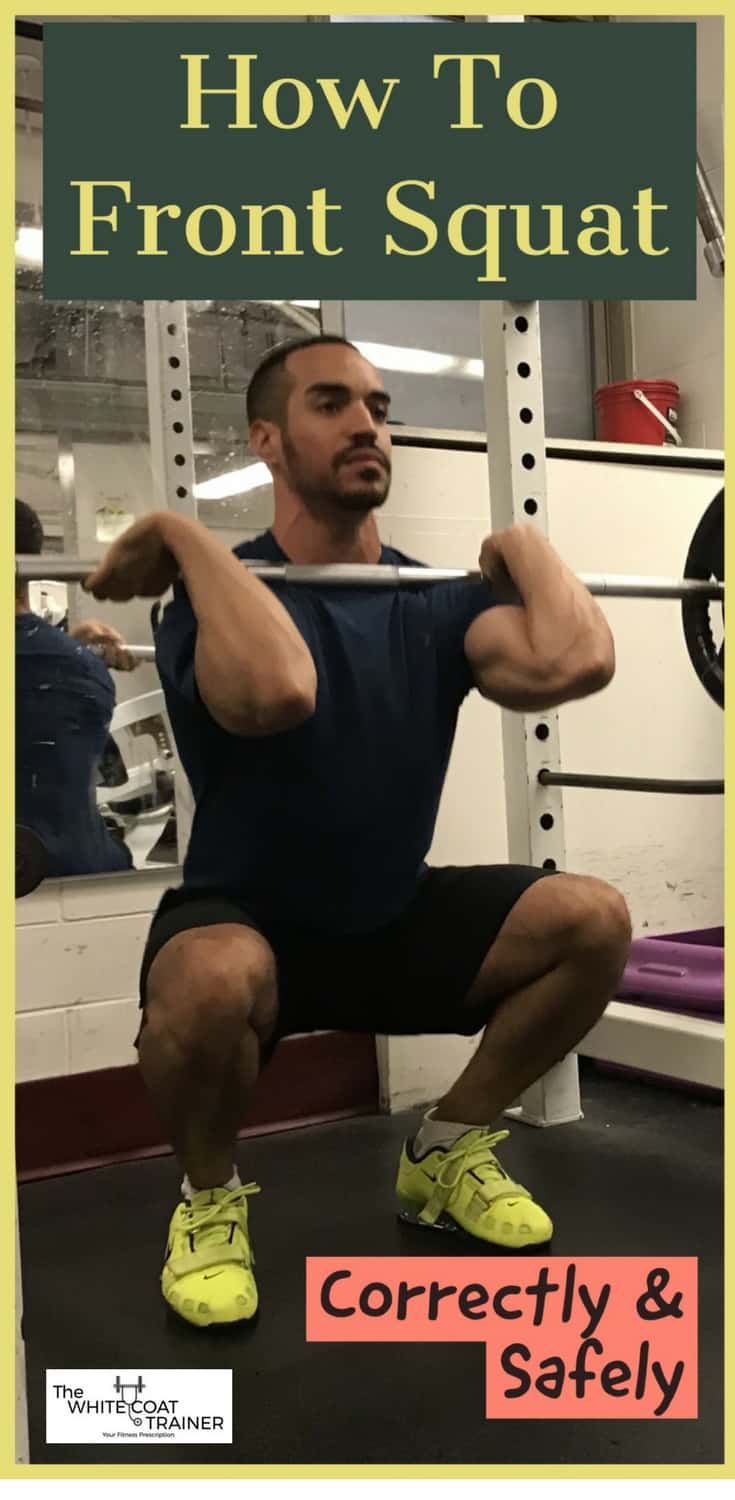
FRONT SQUAT PROPER FORM VIDEO
FRONT SQUAT BENEFITS
- The Front Squat improves mobility in the shoulders, wrists, hips, ankles, knees and thoracic spine
- The Front Squat places less stress on the low back, allowing you to train the squat in the presence of minor low back strains
- Strengthens the quadriceps, glutes, upper back and core musculature which improves lean muscle mass and fat burning
FRONT SQUAT MUSCLES WORKED
- Quadriceps
- Adductors
- Glutes
- Hamstrings
- Core
- Upper Back
PERFORMING THE FRONT SQUAT WITH PROPER TECHNIQUE
- Approach a barbell that is set up in a power rack at the mid-chest (above the nipple) level
- Set your grip on the bar just outside of shoulder width with your thumbs wrapped around the bar
- While maintaining your grip, dive underneath the bar by swinging your elbows forward, extending your wrists, and positioning the bar in the natural shelf created between your clavicles and your anterior shoulders
- Keep your elbows pointed directly in front of you and keep as many fingers wrapped around the bar you can
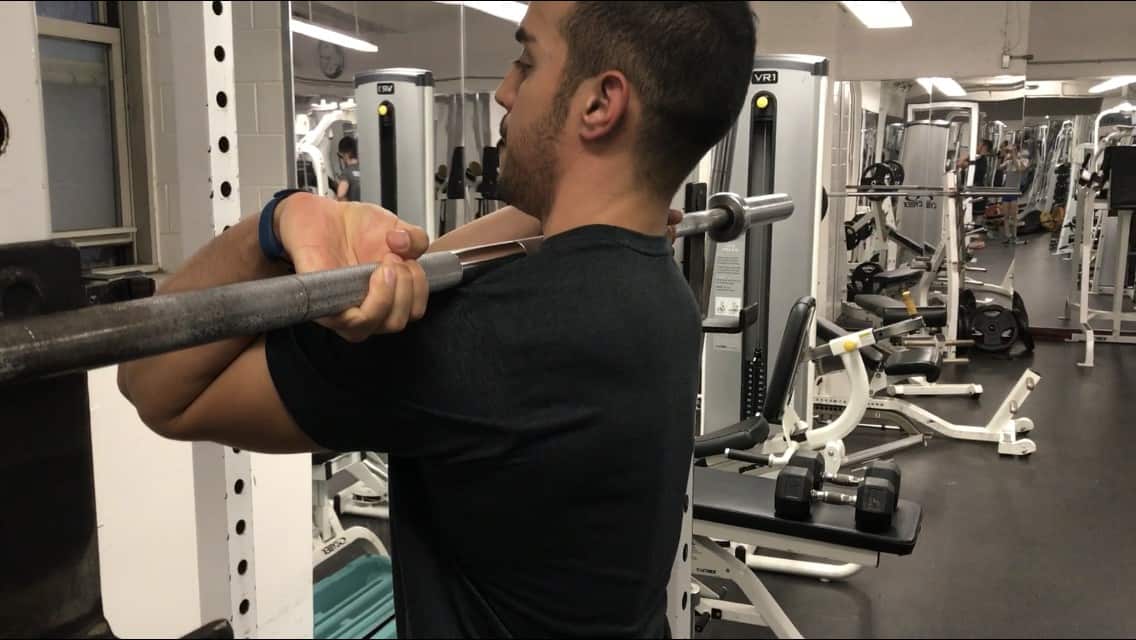
- If your mobility does not allow you to perform this position, you can perform the crossed-arm variation as shown in the video
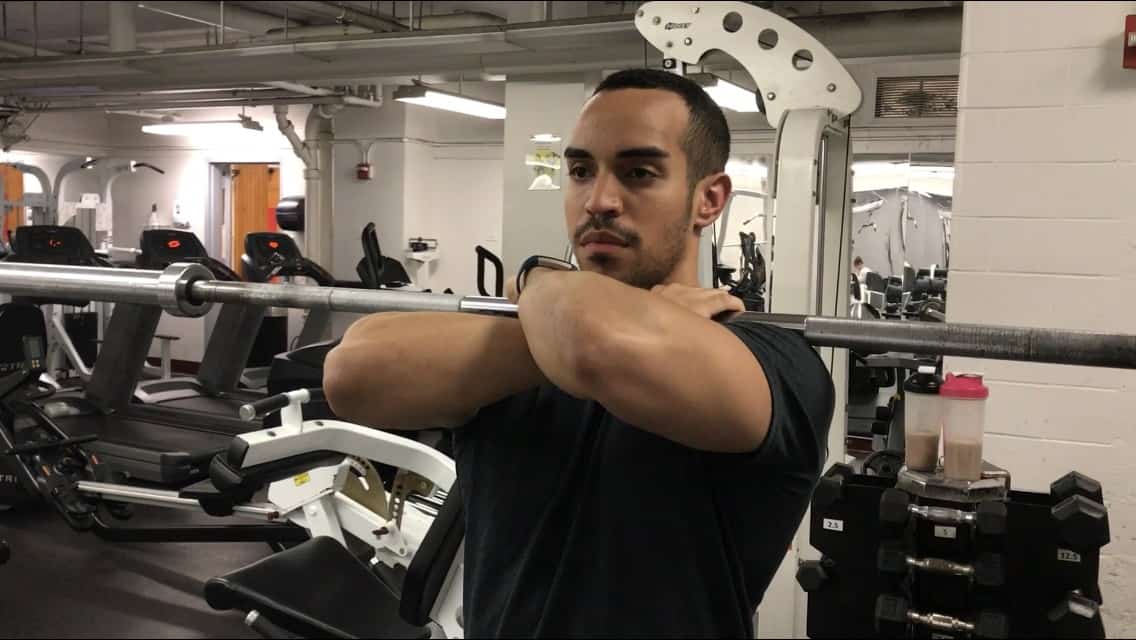
- Stand up with the weight and take up to three steps back to position your feet just outside of shoulder width
- You can point your toes straight, or angles out 15-30 degrees
- Take a big breath, brace your core, and begin the movement by simultaneously bending at the hips and knees until your depth is below parallel
- Keep your knees out, and directly in line with your toes
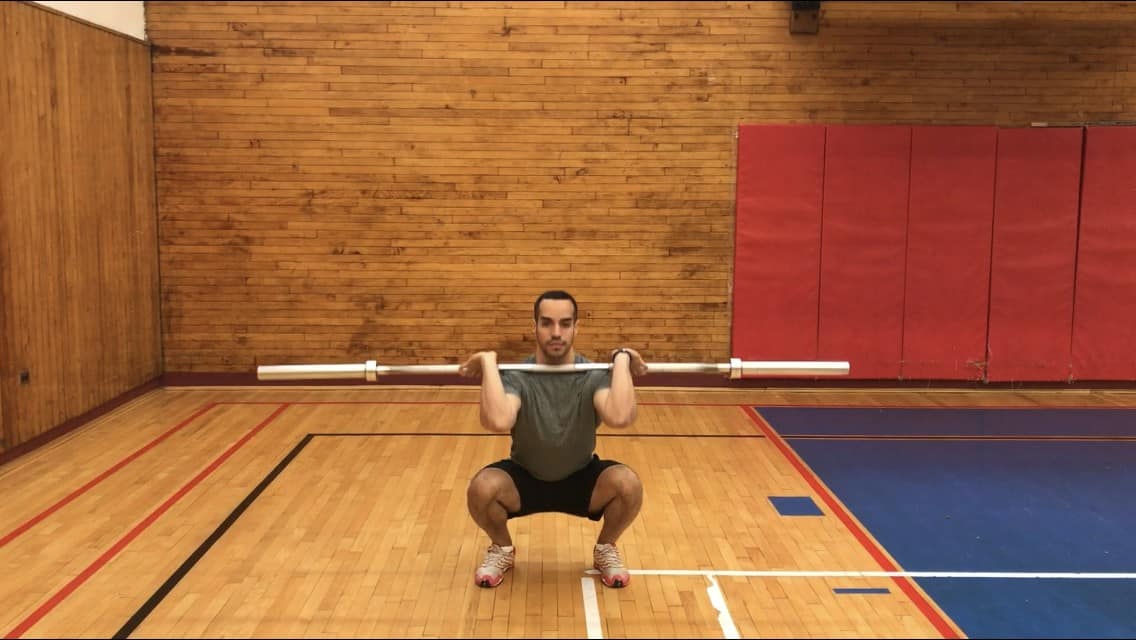
- Below parallel means that your hip crease is below the top of your knee when looking from the side
- Ensure that you keep your chest and your elbows up throughout the entire lift
- Your torso will remain more upright when compared to a back squat in order to keep the barbell in line with your center of gravity
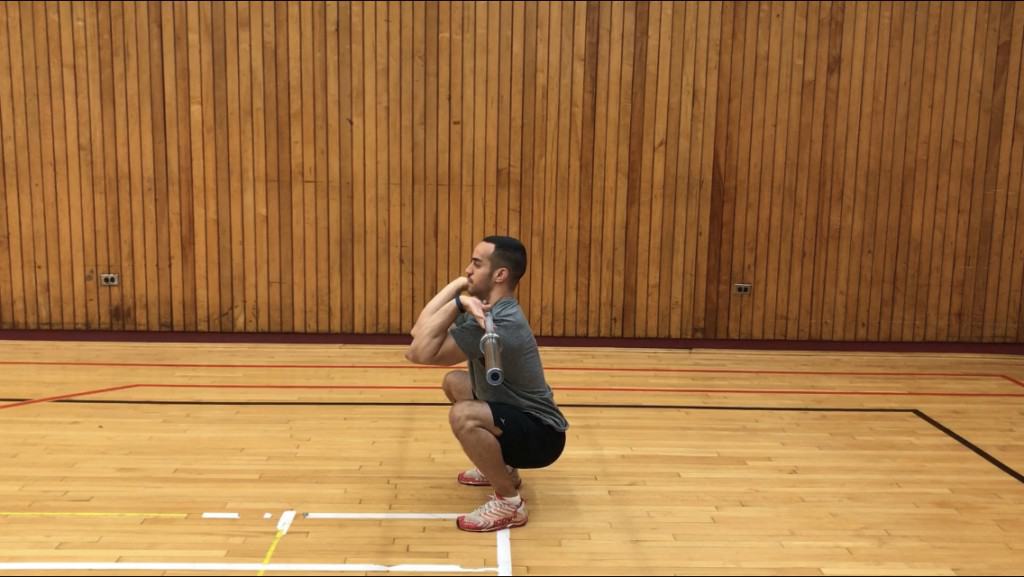
- Your knees will also have more forward travel compared to the back squat when looking from the side
- Reverse the movement by pushing straight back up with even pressure across your feet
- Exhale at the top of the lift and squeeze your glutes to finish extending your hips
COMMON FRONT SQUAT MISTAKES
Not Keeping The Elbows Up
It is extremely important that you keep your elbows as parallel to the floor as possible. Because the barbell is loaded anteriorly, there will be a strong tendency for the weight to pull you forward and easily roll off of you.
The key is to maintain an upright torso, and to keep your elbows as high as possible.
Sitting Too Far Back
The front squat is not a back squat. It is not necessary to sit far back into your heels. The key to this exercise is to maintain an upright torso, and in order to do so, you must try and squat straight down.
You can fix this issue by bending at the hips and knees simultaneously
Not Keeping Your Heels Flat on The Floor
Often times this may be due to poor ankle mobility or improper technique. Concentrate on keeping even pressure across your entire foot throughout the movement and do not let your heels come off the ground.
If they do, you can consider using Olympic lifting shoes, which have a raised heel (~0.75 to 1 inch) and stretching out your calves. My absolute favorite is The Nike Romaleo 2.
INTEGRATING THIS EXERCISE INTO YOUR ROUTINE
Want to know how to use this exercise in your workout? Check out The Best Workout Template For Busy Individuals to learn how to integrate it into your training!
FAQ ABOUT THE FRONT SQUAT
What Front Squat Grip Should I Take?
The best front squat grip is the front rack grip or the clean grip. This is where you set a full (thumbs around) grip on the bar and bring your wrists into full extension.
Many individuals will not have the appropriate flexibility to do this at first, but your wrist flexibility will improve significantly over time if you practice it.
The Front Squat Clean Grip Hurts. Is Wrist Pain Normal?
The first few times you perform the clean grip, your wrist may hurt. This is normal. However, I promise that the discomfort will go away really quickly if you continue to use the grip. Eventually, your wrist flexibility will be able to handle the load easily.
Is It OK To Use The Front Squat Cross Grip?
If you absolutely cannot get into the front rack grip/ clean grip position, then it is okay to use the cross grip. Generally, bigger individuals and bodybuilders have to use the cross grip because of shoulder and wrist flexibility issues.
What Should Be My Front squat Vs Back Squat Ratio?
In general, your front squat will be a lot weaker than your back squat. This is because you are simply using more muscles (namely the back and hips) when performing the back squat.
The actual ratio will vary significantly from person to person depending on your body proportions and squatting mechanics. The more upright and knee bend your back squats have, the closer it’ll be to your front squat.
I Have Knee Pain When I Front Squat. What Should I Do?
The very first thing that you must do if you have knee pain is to stop doing the exercise in the short term. Let the area heal and stretch + foam roll above and below the area of pain (quadriceps and calves).
Pain is usually due to improper positioning and squatting mechanics. When squatting, focus on simultaneously bending at the hips and knees, and pointing your knees outwards over your toes.
In addition, ensure that your feet remain COMPLETELY flat when doing the exercise.
I Lean Forward When I Front Squat. What Should I Do?
This is usually an indicator of the barbell not staying over your center of gravity.
Keep your chest and your elbows up high throughout the movement. If you struggle to keep your torso erect, you probably lack thoracic extension.
Check out our 9 Incredible Stretches to learn how to improve thoracic mobility.
Can I Front Squat With Dumbbells?
You can perform the Front Squat with dumbbells or kettle-bells. Below I have listed Front Squat Alternatives/Similar Exercises.
The Goblet Squat is one of the closest variations of the Front Squat you can perform.
Can I Front Squat On The Smith Machine?
Absolutely not. The Smith Machine is a horrible piece of equipment that puts your body into unnatural positions. I recommend that you never use the Smith Machine for any exercise at all.
Is There An Acceptable Front Squat Machine?
If your gym has a Hack Squat Machine, then this is an acceptable Front Squat variation.
HOW CAN I INTEGRATE THE FRONT SQUAT INTO MY TRAINING?
Check out The WCT Best Workout Template For Busy Professionals to find a simple way to add the front squat and other great exercises into your routine.
FRONT SQUAT ALTERNATIVES/ SIMILAR EXERCISES

Alex Robles, MD, CPT / Brittany Robles, MD, MPH, CPT
Alex & Brittany Robles are physicians, NASM Certified Personal Trainers, and founders of The White Coat Trainer: a resource dedicated to improving the health and fitness of busy professionals using time-efficient strategies. Their advice has been featured in My Fitness Pal, Prevention, Livestrong, Reader’s Digest, Bustle, The Active Times, and more. Learn more about them here.
